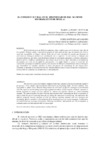Please use this identifier to cite or link to this item:
https://accedacris.ulpgc.es/jspui/handle/10553/77442
| Title: | El choque cultural en el aprendizaje de ELE: alumnos sinohablantes de nivel A1 | Authors: | Alfonzo De Tovar, Isabel Cristina Santana Alvarado, Yaiza |
UNESCO Clasification: | 570111 Enseñanza de lenguas 570510 Sociolingüística |
Keywords: | Choque cultural Sinohablantes Enseñanza de español Culture shock Teaching of Spanish, et al |
Issue Date: | 2015 | Journal: | E-Aesla | Abstract: | El inicio de un curso de ELE para alumnos chinos conlleva una serie de factores más allá de lo cognitivo. Temores, dudas y expectativas propias de todo comienzo hace que los alumnos de nivel A1 sean más susceptibles al choque cultural. Cada día son más conocidas las teorías que fomentan la activación de estrategias afectivas en coordinación con lo cognitivo. En este sentido, se propone una secuencia didáctica que tiene como finalidad el diseño de actividades ajustadas a criterios culturales y afectivos de los estudiantes sinohablantes. Las mismas surgirán de los datos obtenidos en el análisis de necesidades, así como de la ciudad de procedencia y la ciudad donde se realiza la inmersión. En conclusión, esta propuesta didáctica aporta a los docentes de ELE para sinohablantes nuevas estrategias que desarrollan las variables afectivas al inicio del proceso de aprendizaje de una lengua meta. Asimismo, se fomenta la investigación docente interdisciplinaria para el logro de mejoras pedagógicas y el desarrollo de competencias comunicativas e interculturales. The start of a course for Chinese students of ELE has a number of factors beyond the cognitive perspective. Fears, doubts and expectations inherent in any beginning makes A1 level students more susceptible to culture shock. Theories that promote the activation of affective strategies in coordination with the cognitive are becoming increasingly popular nowadays. In this regard, a didactic sequence is herein suggested to design activities adjusted to cultural and affective criteria of Chinese-speaking students. The same activities will arise from the data obtained after conducting the needs assessment, as well as from the city of origin and from the city where the immersion is carried out. In conclusion, this didactic proposal provides teachers of ELE for Chinese-speaking students with new strategies for developing affective variables at the beginning of the learning process in a target language. Furthermore, the interdisciplinary teaching research for achieving educational improvement and the development of communication and intercultural skills is encouraged. |
URI: | https://accedacris.ulpgc.es/handle/10553/77442 | ISSN: | 2444-197X | Source: | E-Aesla [ISSN 2444-197X], n. 1 | URL: | http://dialnet.unirioja.es/servlet/articulo?codigo=7728977 |
| Appears in Collections: | Artículos |
Page view(s)
241
checked on Dec 30, 2023
Download(s)
81
checked on Dec 30, 2023
Google ScholarTM
Check
Share
Export metadata
Items in accedaCRIS are protected by copyright, with all rights reserved, unless otherwise indicated.
